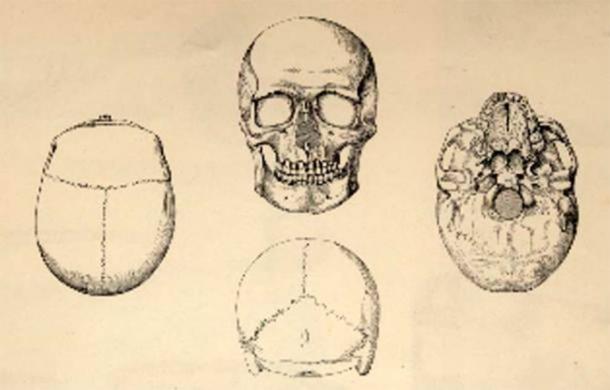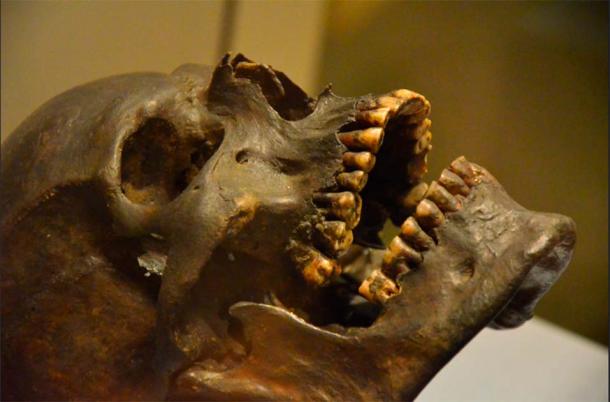The Gristhorpe Man: A Bronze Age Skeleton with a Story to Tell
On July 10, 1834, William Beswick excavated a barrow on his land in Gristhorpe, North Yorkshire, England. What he found gave him quite the surprise. Beswick discovered a coffin in the shape of a scooped-out oak tree. Inside the coffin was something special - the skeleton of a Bronze Age man, known today as the Gristhorpe Man.
When Beswick made his discovery members of the Scarborough Philosophical Society, which consisted of doctors and other learned members of society, were also present. Seeing that the skeletal remains of the Gristhorpe Man were so fragile, they made an attempt to preserve them. Filling a laundry copper with horse glue, the bones were boiled for eight hours. Thanks to them, the skeleton is still complete today. Unfortunately the process they used to conserve the bones has rendered the study of DNA or the use of collagen from the body for dating purposes impossible.
The Gristhorpe Man, his coffin and his grave goods were donated to the Scarborough Philosophical Society, and displayed at the Rotunda Museum in Scarborough. A monograph of the discovery was written by William Crawford Williamson, the 17-year-old son of the museum’s first keeper, John Williamson. This piece of work included drawings of the skull and grave goods, as well as details regarding the method of preservation and the coffin dimensions.
- The Art of Reconstructing the Faces of Ancient Humans (Video)
- 7,000-Year-Old Skeleton in Foetal Position Discovered in Poland

Drawings of the Gristhorpe Man's Skull, J. and W.C. Williamson (Scarborough Museum's Trust)
Insights into the Gristhorpe Man
Since then, many new and exciting discoveries have been made about the Gristhorpe Man. Perhaps one of the most obvious features of the Gristhorpe Man was his height. Measuring at a height of about 6 feet (1.8 meters), the Gristhorpe Man was extremely tall for the Bronze Age era. This could have been the result of a relatively good diet.
This in turn allowed archaeologists to infer that the Gristhorpe Man was an individual of high social status, perhaps a tribal chief. Additional clues that indicate this status may be found in the grave goods. Before being placed inside the oak coffin, the body of the Gristhorpe Man was wrapped in a skin cloak, of which only fragments survive today. Other grave goods included a dagger, flint tools, a wicker basket containing food residue, and a bark vessel, which, according to modern research, contained milk.
- The Bronze Age Srubna Culture and their Unique Timber Graves for the Dead
- Earliest bronze dagger ever found in Britain rediscovered with ancient chieftain
It is the dagger that will help archaeologists date the Gristhorpe Man more precisely. This dagger was made of bronze, and had a polished whalebone pommel. Based on the composition of the metal, it has been suggested that the bulk of it came from south-western Ireland, whilst the tin originated in south-western England. In addition to shedding light on ancient trade routes in the British Isles, this knowledge may also allow comparison with other British examples where radiocarbon dates are available.
Gristhorpe Man a Warrior?
Modern science has also revealed that the Gristhorpe Man was likely to have been a warrior. This is due to the presence of numerous healed fractures. While we may never be able to know if the Gristhorpe Man’s personality matched that of a typical Bronze Age warrior, some Victorians believed that it was possible. Using the now debunked ‘science’ of phrenology, some claimed that a person’s personality may be determined by the shape of the skull. Based on the skull of the Gristhorpe Man, a certain Dr. Elliotson concluded that his characteristics included a high level of combativeness and destructiveness, as well as a low level of constructiveness and imitation.
In the book, Gristhorpe man: A Life and Death in the Bronze Age, by Nigel D. Melton, Janet Montgomery and Christopher Knusel, authors document the analysis of scientific studies undertaken at the University of Bradford, and found evidence of a non-malignant- brain tumor in Gristhorpe Man's remains, which may have been the cause of his death. Intriguing revelations that come to light about the societal standing, cross-regional connections, and the burial ceremony linked to this mysterious older gentleman.

Teeth of Gristhorpe Man (Ben Sutherland/CC BY 2.0)
The isotopic analysis (a technique relying on the radioactive decay of specific elements) of his tooth suggests a probable Scarborough origin for Gristhorpe Man, implying a consistent meat-rich diet throughout his life. Through tooth dentine and thigh bone radiocarbon dating performed at Bradford University, it has been revealed that his passing occurred roughly 4000 years ago.

Facial Reconstruction of the Gristhorpe Man (Scarborough Museum's Trust)
The Gristhorpe Man Speaks
Today, Dr. Elliotson’s phrenological assessment of the Gristhorpe Man would be questioned. However scientists have found a different use for the Gristhorpe Man’s skull. Using the results of a large number of tests and investigations, a facial reconstruction of the Gristhorpe Man has been created. Researchers have also gone one step further by using modern software techniques to animate the Gristhorpe Man’s facial reconstruction. As a result, visitors to the Rotunda Museum are able to not only see how the Gristhorpe Man may have looked like when he was alive, but also hear him speak - albeit in modern English rather than a form of Proto-Celtic language that he might have spoken.
In 2019, the famous Bronze Age Gristhorpe Man was transported to a controlled museum store while building works took place at the Rotunda. The remains were returned to the Rotunda Museum for display.
Top image: Scarborough Gristhorpe Man. Source: Emőke Dénes/CC BY-SA 4.0
By Ḏḥwty
References
BBC, 2007. A 4000 year old VIP comes to Bradford! Available at: http://www.bbc.co.uk/bradford/content/articles/2007/07/10/bradford_gristhorpe_man_feature.shtml
BBC, 2010. Gristhorpe Man speaks after 4,000 years. Available at: http://news.bbc.co.uk/local/york/hi/people_and_places/history/newsid_8877000/8877132.stm
Bean, D., 2010. Scientists give Bronze Age Gristhorpe Man a face and voice.
Available at: http://www.yorkpress.co.uk/news/8310552.Scientists_give_face_and_voice_to_Bronze_Age_man/
Down, S., 2013. Holy cow: Milk residues in ancient bark vessel.
Available at: http://www.spectroscopynow.com/details/ezine/13d265e4500/Holy-cow-Milk-residues-in-ancient-bark-vessel.html?&tzcheck=1&tzcheck=1
Highfield, R. & Fleming, N., 2006. Gristhorpe Man 'was Bronze Age warrior chieftain'.
Available at: http://www.telegraph.co.uk/news/1528255/Gristhorpe-Man-was-Bronze-Age-warrior-chieftain.html
Melton, N. et al. 2017. Gristhorpe Man. An Early Bronze Age log-coffin burial scientifically defined. Routledge. DOI:10.4324/9781003341888-17
Rushton, J., 2015. Gristhorpe man - the reaction of Victorians.
Available at: http://www.scarboroughsmaritimeheritage.org.uk/agristhorpeman.php
The Scarborough, 2010. Gristhorpe Man slowly gives up his secrets. Available at: http://www.thescarboroughnews.co.uk/news/local/gristhorpe-man-slowly-gives-up-his-secrets-1-1455100
Melton, N. et al. 2017. Gristhorpe Man. An Early Bronze Age log-coffin burial scientifically defined. Routledge. DOI:10.4324/9781003341888-17


















Comments
The field of study should move away from their bad habit of dubious conjecture, and artistic creative licence (not scientific!) and focus primarily on genetic analysis. If the DNA can be sequenced, it can be matched up with the closest living person via simple AI algorithm. Crime labs do this all the time. Hair and eye color, and facial characteristics, could also be derived. If say, the ancient man’s closest living DNA match is a low IQ criminal, that would be somewhat interesting. But maybe he matches up instead with a modern genius or engineering whiz. In any event, that’s the direction the industry should take. It gets us clearly closer to the truth, and away from the fantasy.
Nobody gets paid to tell the truth.
What Proto-Celtic? Just asking how can you even know that...Anyway, аncient tribe of Dardanians, an Illiryan tribe from what is today South Serbia, used to bury their dead in tree trunks like that during bronze age. Some graves were found in South Serbia/Kosovo, and as I recall lectures of one professor of archaeology during my studies, who was pretty much against conventional (e.g. faked) archaeology, many of these tree coffins were literally destroyed by goverment researchers in 50s/60s, by throwing them in river after excavations. Why? There are answers...
Thank you for this article! Coincidentally, I came across his story only a couple of days ago whilst researching somthing else, so it was a pleasant surprise to see your post. It’s also encouraged me to add the Rotunda Museum to my list – can’t believe I’ve never been – visited Scarborough loads of times.
Great that they managed to preserve the bones in that time, but a shame it destroyed the DNA. Thanks again!
Sculptures, carvings & artwork inspired by a love of history & nature: www.justbod.co.uk